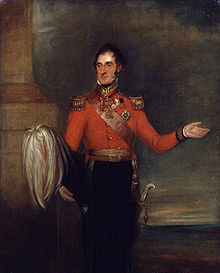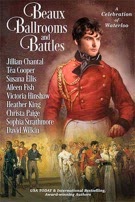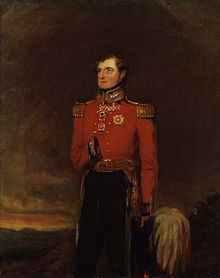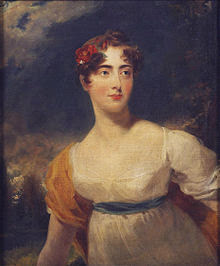Regency Personalities Series
In my attempts to provide us with the details of the Regency, today I continue with one of the many period notables.
General Lord Robert Edward Henry Somerset
19 December 1776 – 1 September 1842

Robert Edward Henry Somerset
General Lord Robert Edward Henry Somerset was the third son of the 5th duke of Beaufort, and elder brother of Lord Raglan.
Joining the 15th Light Dragoons in 1793, he became captain in the following year, and received a majority after serving as aide-de-camp to the Duke of York in the Dutch expedition of 1799. At the end of 1800 he became a lieutenant-colonel, and in 1801 received the command of the 4th Dragoons. From 1799 to 1802 he represented the Monmouth Boroughs in the House of Commons, from 1803 to 1823 sat for Gloucestershire and from 1834 to 1837 was MP for Cirencester.
He commanded his regiment at the battles of Talavera and Buçaco, and in 1810 received a colonelcy and the appointment of ADC to the king. In 1811, along with the 3rd Dragoon Guards, the 4th Dragoons fought a notable cavalry action at Usagre, and in 1812 Lord Edward Somerset was engaged in the great charge of Le Marchant’s heavy cavalry at Salamanca. His conduct on this occasion (he captured five guns at the head of a single squadron) won him further promotion, and he made the remaining campaigns as a major-general at the head of the Hussar brigade (7th, 10th and 15th Hussars).
At Orthes he won further distinction by his pursuit of the enemy; he was made KCB, and received the thanks of parliament. At Waterloo he was in command of the Household Cavalry Brigade, which distinguished itself not less by its stern and patient endurance of the enemy’s fire than by its celebrated charge on the cuirassiers of Milhaud’s corps.
The brigadier was particularly mentioned in Wellington’s despatches, and received the thanks of parliament as well as the Army Gold Cross with one clasp for his services at Talavera, Salamanca, Vitoria, Orthez, and Toulouse; the Maria Theresa and other much-prized foreign orders.
He died a general and GCB in 1842.
The ‘Lord Somerset Monument’ stands high on the Cotswold Edge at Hawkesbury, Gloucestershire (grid reference ST772878), near the ancestral home of Badminton, Gloucestershire. It was erected in 1846.
On 17 October 1805 he married Lady Louisa Augusta Courtenay (1781 – 8 February 1825), a younger daughter of William Courtenay, 8th Earl of Devon, with whom he had several children, three sons and five daughters:
- Robert Henry Somerset (1806–1807)
- Louisa Isabella Somerset (1807–1888)
- Frances Caroline Somerset, later Mrs Theophilus Clive (1808–1890) who married 1840 Theophilus Clive (d. 1875).
- Blanche Somerset, later Mrs Charles Locke (1811–1879) who married 1845, Rev. Charles Courtenay Locke (d. 1848)
- Matilda Elizabeth Somerset, later Mrs Horace Marryat (1815-3 April 1905) (portrait 1843) who married 1842 Horace Marryat
- Lt-Gen. Edward Arthur Somerset (1817–1886) married Agatha Miles (1827 – 1912), daughter of Sir William Miles, Bt
- Georgina Emily Somerset (1819-?) who married 1852 Hon Robert Neville Lawley (who died 1891)
- Augustus Charles Stapleton Somerset (1821–1854)
And Coming on April 1st, 2015
Beaux Ballrooms and Battles anthology, celebrating the 200th anniversary of the victory at Waterloo in story.

Looks good, huh? The talented writer and digital artist, Aileen Fish created this.
It will be available digitally for $.99 and then after a short period of time sell for the regular price of $4.99
The Trade Paperback version will sell for $12.99

My story in the anthology is entitled: Not a Close Run Thing at All, which of course is a play on the famous misquote attributed to Arthur Wellesley, “a damn close-run thing” which really was “It has been a damned nice thing — the nearest run thing you ever saw in your life.”
Samantha, Lady Worcester had thought love was over for her, much like the war should have been. The Bastille had fallen shortly after she had been born. Her entire life the French and their Revolution had affected her and all whom she knew. Even to having determined who she married, though her husband now had been dead and buried these eight years.
Yet now Robert Barnes, a major-general in command of one of Wellington’s brigades, had appeared before her, years since he had been forgotten and dismissed. The man she had once loved, but because he had only been a captain with no fortune, her father had shown him the door.
With a battle at hand, she could not let down the defenses that surrounded her heart. Could she?
As her father’s hostess, she had travelled with him to Brussels where he served with the British delegation. Duty had taken her that night to the Duchess of Richmond’s ball. The last man she ever expected to see was Robert, who as a young captain of few prospects, had offered for her, only to be turned out by her father so that she could make an alliance with a much older, and better positioned (wealthy), aristocrat.Now, their forces were sure to engage Napoleon and the resurgent Grande Armée. Meeting Robert again just before he was to be pulled into such a horrific maelstrom surely was Fate’s cruelest trick ever. A fate her heart could not possibly withstand.
































